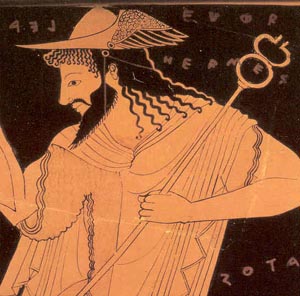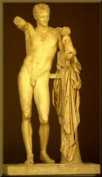
|
9o |
|

| Hermes is the patron of thieves,
roads, wanderers, orators, and commerce. As a patron of travelers,
he is commonly shown wearing a straw-brimmed hat. His most famous
representation is a sculpture by Bellini, showing him alight
on one winged foot, with the Caduceus in his hand and a helmet/sun
hat on his head. He is one of the twelve main Olympian gods,
and serves as a messenger between the other gods. It is Hermes's
job to carry newly dead souls down into Hades, and deliver them
to Chiron. He invented the lyre, the pipes, the musical scale,
astronomy, weights and measures, boxing, gymnastics, and the
knowledge to care for olive trees. He has many different names,
being called Argiphontes, for having killed the All-seeing Argus
who guarded Io, and Psychopompus for being the guide of souls
to the Underworld. The Romans call him Mercury. Hermes was originally
a phallic god, being attached to fertility and good fortune.
Hermes was the patron of roads and boundaries, as pillars called hermae containing his head (with a beard) were used as road and boundary markers. They were rectangular and made out of stone or bronze, with male genitalia located near the bottom. In Athens they were used as symbols to ward off evil. Like his father, he had many affairs with goddesses, nymphs, and mortals. Hermes is believed to be the father of Pan, Abderus and Hermaphroditus. He is famous for putting Argos, the hundred eyed giant, asleep and cutting his head off to release the captive Io. He convinced Calypso to release Odysseus from her charms, and additionally helped Odysseus and his men from being transformed into pigs by giving them a magic herb. He guided Eurydice back into the underworld after Orpheus looked at her. He was the protector of sheep and cattle herds, and associated with nature gods such as Pan. His sacred number was four, symbolizing the forth day of the month which was his birthday. In archaic art he is portrayed as a full-grown man with a bearded, occasionally bearing a sheep on his shoulders. From the latter part of the 5th Century he was portrayed as a young beardless athlete. |
| According to the widely accepted
myth concerning the birth of Hermes, his father was Zeus, while
his mother was Maia. She gave birth to him in the morning at
the mountain Cyllene in Arcadia. His mother wrapped him in swaddling
bands, and then fell fast asleep herself. While Maia was asleep,
he scampered out and ran off to Thessaly, where his half-brother
Apollo kept his herds. He tied skins around the feet of the cattle
so the sound of their escape could not be heard, and then led
them to a grotto near the city of Phylos. He sacrificed two of
the cattle, hiding the rest in a cave, and then returned to Cyllene.
When the furious Apollo found all his cattle missing, he discovered
by divination that Hermes had stolen them, and went of to Mount
Cyllene. However, in the meantime the young Hermes had found a tortoise, and by removing its entrails and stringing nine cow tendons (or strips of linen) across the shell in honor of the nine muses was able to create the first lyre. When Apollo arrived in mount Cyllene he was only able to find the innocent infant still wrapped in his swaddling blankets (as he had crawled into them before Apollo came). Furious at being tricked by the tiny child, Hermes took him to Zeus and implored him to make the child reveal the location of the cattle. After at first denyingthe theft and finding that nobody believed him, Hermes was forced to lead Apollo to the location of the stolen cattle. However, while he was doing this Apollo saw the lyre he had created and was willing to give all of his cattle to Hermes in exchange for it. After the exchange of cattle, Hermes went to the fields and made himself a shepherd's pipe, or syrinx (pan-pipe). Upon hearing the beautiful melody he played on it, Apollo offered to give him the golden staff he used in herding them in exchange. Hermes accepted this offer, but also convinced Apollo to teach him the art of divining by using pebbles.The golden staff that Hermes received, the Caduceus, represents riches and wealth and keep him unharmed. The caduceus was originally depicted as a willow wand intertwined with ribbons, the traditional badge of a herald, but these later became to symbolize two snakes. An additional story was later created to support this, telling how he separated two fighting snakes with his caduceus, and henceforth they twined themselves in peace around his staff. |
 |
 |